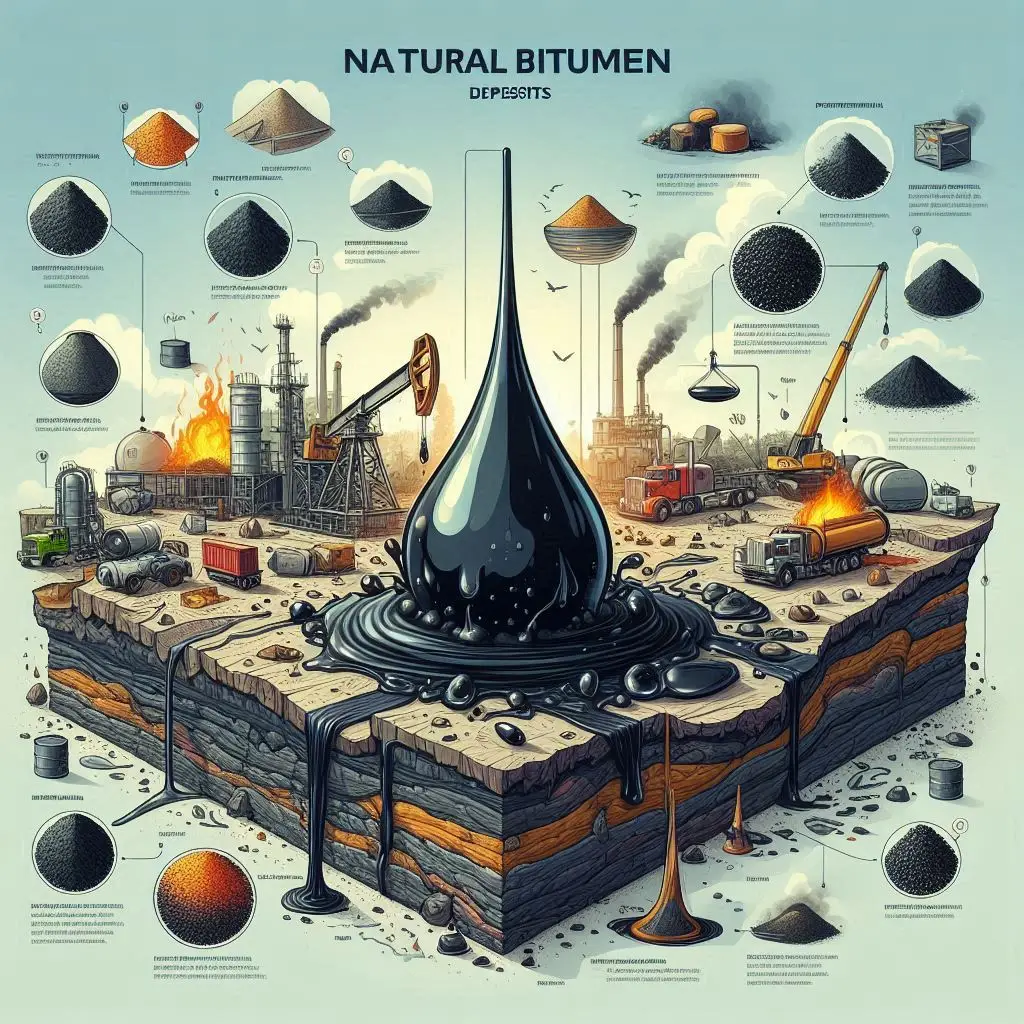
Natural bitumen deposits
This article, natural bitumen deposits, examines the properties, origin, distribution, techniques of extraction, and effects of natural bitumen deposits on the environment.
Natural bitumen, often known as asphalt, is a very viscous, sticky, and black petroleum product. It is present in many different geological formations across the world, and because of its industrial and economic significance, its deposits have attracted a lot of attention.
Natural bitumen deposits are an important but complicated resource with broad industrial and economic ramifications. The ethical and sustainable extraction and use of natural bitumen are critical given the growing worldwide need for energy and building materials. The continuous investigation, technical advancements, and an unwavering dedication to ecological responsibility are essential components in guaranteeing that natural bitumen makes a constructive contribution to human progress while maintaining the fragile equilibrium of our ecosystems. To achieve a healthy balance between economic growth and environmental sustainability, we must explore and harness natural bitumen resources with caution and in a comprehensive manner as we navigate the future.
Features of Natural Bitumen: The special qualities of natural bitumen set it apart. It is a complex combination of high molecular weight hydrocarbons that often includes molecules related to sulfur, nitrogen, and oxygen. Its firmness varies according to several elements including temperature and the deposit's unique makeup, ranging from a thick, tar-like material to a more solid form.
Natural bitumen development: There are many different geological processes that contribute to the development of natural bitumen. Most often, the remnants of extinct marine microorganisms—algae in particular—are the source of these deposits. Under extreme pressure and temperature, these organic molecules change over millions of years to become hydrocarbons, which in turn produce natural bitumen.
Global Distribution of Natural Bitumen: Bitumen reserves are dispersed across the world's different areas. Russia, Iran, Venezuela, the United States, and Canada are among the nations with notable deposits. Bitumen from each site has its own distinct qualities; among the biggest and most commercially important deposits are the Canadian oil sands.
Extraction Techniques: Because natural bitumen is so sticky, extracting it requires a number of intricate steps. Surface mining techniques and in-situ procedures like steam-assisted gravity drainage (SAGD) are often used. These techniques have an impact on the environment, and in order to reduce their ecological imprint, cutting-edge technology is needed.
Economic Significance: Natural bitumen has a wide range of industrial uses and is a valuable resource. It is an essential part of the process that creates waterproofing materials, asphalt for building roads, and feedstock for the petrochemical sector. Natural bitumen resources are especially important economically in areas with well-established businesses for extraction and processing.
Environmental Consequences: Natural bitumen extraction and processing may have an impact on the environment. Concerns about surface mining include deforestation, ecosystem disturbance, and water usage. Even while in-situ techniques lessen certain environmental effects, they nevertheless present difficulties because of the energy-intensive extraction process and possible groundwater pollution.
Technical breakthroughs: The environmental issues related to bitumen extraction from natural sources are being addressed by ongoing research and technical breakthroughs. The industry's dedication to reducing its environmental effect is shown by advancements in extraction techniques, such as solvent-assisted procedures, and the creation of more environmentally friendly technology.
Emerging Markets and Alternative Uses: Natural bitumen is finding new uses in emerging markets outside of its conventional applications. The advancement of cutting-edge technology has created opportunities for bitumen to be used in cutting-edge goods including high-performance battery production and bituminous binders for sustainable pavements. By using this resource in novel ways, these varied uses not only increase the market for natural bitumen but also support sustainable practices.
Difficulties and Regulatory Framework: There are some difficulties involved in the extraction and processing of natural bitumen. In order to ensure responsible resource management and environmental preservation, regulatory frameworks are essential. Encouraging stakeholder involvement, strong regulation, and monitoring systems are necessary to strike a balance between industrial interests and environmental protection. Regulations must advance together with technology in order to match the shifting needs of the natural bitumen sector.
Impact of the Worldwide Energy Transition: Concerns over the long-term sustainability of natural bitumen are raised by the continuous worldwide shift towards greener energy sources. With the global trend towards renewable energy sources, the natural bitumen business must adjust to the changing market conditions. Research on carbon capture and utilization technologies in conjunction with the investigation of sustainable extraction techniques may establish natural bitumen as a transitional resource for the global energy transition.
International Cooperation and Diplomacy: In order to solve common problems and maximize resource management, international cooperation is essential given the worldwide distribution of natural bitumen reserves. When it comes to promoting collaboration between countries that have substantial bitumen deposits, diplomacy is essential. Collaborative research projects, technological exchanges, and coordinated environmental endeavors may support the worldwide responsible use of natural bitumen.
Prospects for the Future and a Conclusion: The potential of natural bitumen in the future is contingent upon the careful balancing act of technical advancement, ecological responsibility, and financial factors. The industry's future will be determined by its capacity to adopt sustainable practices, work together, and adjust to changing energy environments. Our road toward a more sustainable and resilient future becomes increasingly dependent on the proper use of natural bitumen resources as we work through the challenges of striking a balance between ecological protection and economic growth. In summary, the complex characteristics of natural bitumen need a comprehensive strategy that incorporates international cooperation, regulation, and innovation to guarantee its continuous support of human development without endangering the condition of the environment.
https://www.novintrades.com/products/33?title=bitumen-4050
https://www.novintrades.com/products/32?title=bitumen-6070
https://www.novintrades.com/products/31?title=bitumen-80-100

